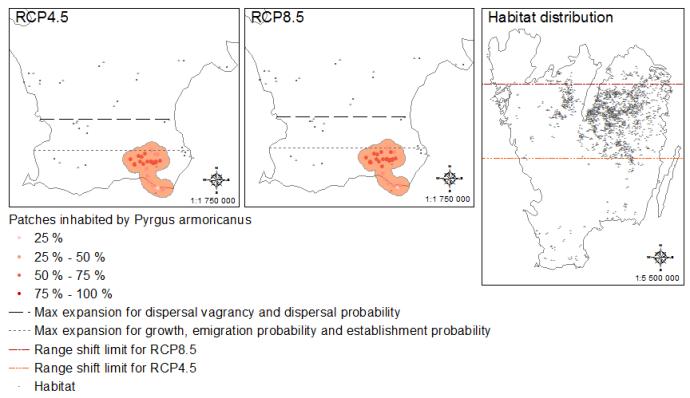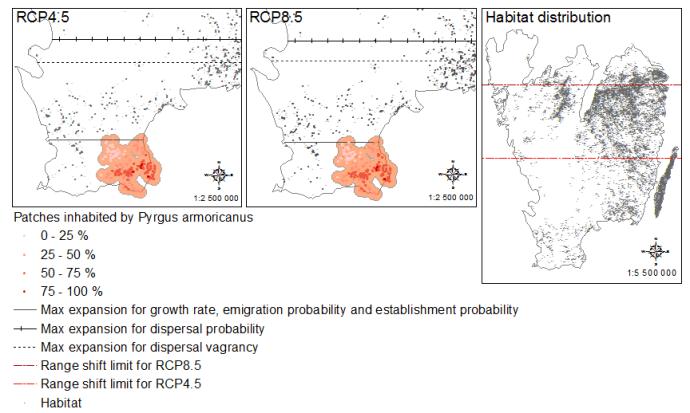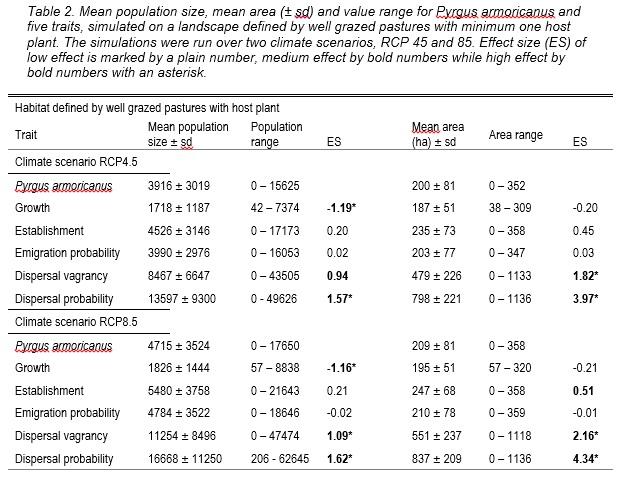Range shift for a specialized butterfly
Pyrgus armoricanus
The success of Pyrgus armoricanus northward expansion was restricted during both climate scenario RCP4.5 and RCP8.5, but the species were predicted to slightly increase in population size and inhabited area. One could expect their mean area to increase to 52 ± 36 ha, with a maximum of 117 ha. The population size could also be expected to increase, from a mean of 509 ± 388 individuals to about 1119 ± 1049 (Table 1). The butterfly did not manage to expand its territory northwards, but did in up to 50 % of the simulations increase its inhabited area by occupying habitat patches south of their current distribution (Figure 1). Even though the success of the butterfly northward expansion was limited for either climate scenario, the warmer climate in RCP8.5 enabled a larger mean population size of 1504 ± 1323 individuals and mean inhabited area of about 61 ± 39 ha.
Traits of a specialized butterfly
The expansion success of a butterfly assuming the highly specialized habitat requirements of P. armoricanus was low regardless of trait and climate scenario (Figure 1). The difference in population size and inhabited area between P. armoricanus and a butterfly with higher establishment ability or a higher emigration probability were low, while a decreased growth rate or an increased dispersal ability had a greater effect. A lower growth rate lead to a lower population size (effect size = - 0.73), and a slightly larger inhabited area (effect size = 0.28). Increased dispersal ability, either by assuming a higher dispersal vagrancy or dispersal probability, resulted in a higher population size and area inhabited comparing to P. armoricanus. The difference between P. armoricanus and mean inhabited area, with an effect size from 0.94 to 2.46, was greater than between P. armoricanus and mean population size (Table 1).
The tested traits followed the same trends under climate scenario RCP8.5 as in RCP4.5, except that the difference between P. armoricanus and the traits was smaller in the first mentioned (besides growth, where the difference in mean population slightly increases).
The northward expansion was limited regardless of trait, but an increased dispersal vagrancy increased their expansion from 0 to a maximum of 15.1 km north from their original habitat, with a mean of about 14.6 ± 0.8 km (Table 4) for both climate scenarios. An increased dispersal probability raised the mean expansion to around 14.7 ± 0.8 km for RCP4.5 and RCP8.5.
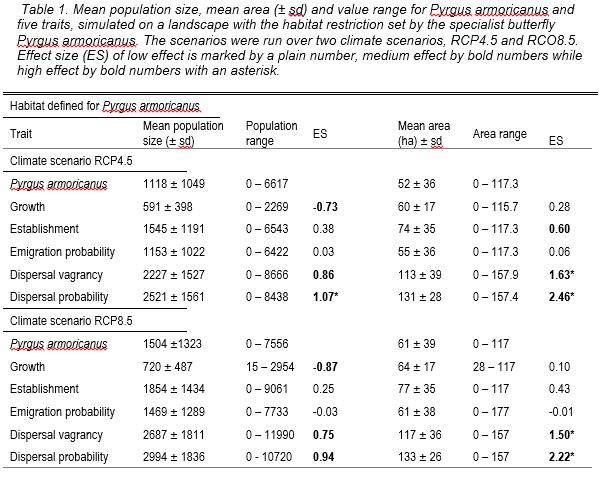
Range shift for a medium specialized butterfly
Pyrgus armoricanus
Pyrgus armoricanus could regardless of climate scenario follow its range shift to a maximum of 18.1 km (Table 4). This was the maximum limit even their dependability of south facing slopes was removed, generating a mid-specialist landscape. The species had a mean expansion of 1.5 ± 5.3 for RCP4.5 and 14.2 ± 4.9 for RCP8.5. Even though the northward expansion was limited, they spread both east and south and increase both their population size and area inhabited (Figure 2). The mean population increased to 3916 ± 3019 and 4715 ± 3524 for RCP 4.5 and RCP8.5 respectively, while the mean area was about 200 ha for both climate scenarios (Table 2).
Traits of a medium specialized butterfly
A medium specialized butterfly had in general a greater chance of population growth and increasing its distribution compared to a specialized butterfly. Climate scenario RCP4.5 and RCP8.5 had a similar effect on either trait tested, but the latter assumed a higher temperature which enabled the populations to grow larger. The mean population size and area inhabited for a medium specialized butterfly declined when a low growth rate was assumed. Both population size and area inhabited increased if the establishment probability or the emigration probability was greater (Table 2), but the dispersal traits had the greatest effect. The butterfly with a higher vagrancy doubled both the population size and inhabited area compared to the butterfly resembling P. armoricanus. This increase was even greater if a higher dispersal probability was assumed, where the mean population size reached about 14 000 and the inhabited area around 800 ha in climate scenario RCP4.5.
Range shift ability increased for a butterfly with more general habitational requirements compared to the highly specialized butterfly (Figure 2), but the ability differed depending on the traits held by the butterfly. The expansion of the butterfly did not differ greatly for an increased establishment ability or emigration probability, in fact they stayed within the same area as P. armoricanus (Table 4). The mean expansion for the butterfly with increased establishment probability reached 15.3 ± 4.2 km for RCP4.5 and 15.3 ± 3.8 for RCP8.5. An increased emigration probability lowered the mean expansion to around 13.7 ± 5.2 km for both climate scenarios. Even though a decreased growth rate had a clear declining effect on the number of individual butterflies, they managed to expand their distribution the same distance as P. armoricanus, even though the mean expansion was roughly 4 km shorter (Table 4). The dispersal traits had the greatest effect on the northward expansion for the medium specialized butterfly. The butterfly could enlarge its distribution from 18 km up to about 82 - 86 km if it had a higher dispersal vagrancy (Figure 2, Table 4), with a mean expansion of 50.4 ± 19.9 km for RCP4.5 and 55.7 ± 17.3 for RCP8.5. The butterfly with a higher dispersal probability had a mean expansion of 68.8 ± 9.9 km for RCP4.5 and 70.6 ± 10 km for RCP8.5, with a maximum expansion that reach about 102 km during 50 years for either climate scenario.
Range shift for a generalized butterfly
Pyrgus armoricanus
The increased amount of habitat available for P. armoricanus (assuming that they could survive on well grazed pastures) highly increased their population size, area inhabited and their ability to expand north. Their mean population size could reach as high as about 58 000 individuals during climate scenario RCP4.5 and almost 78 000 during climate scenario RCP8.5, while mean area inhabited reached about 2300 ha and 2500 ha for respective climate scenario (Table 3). Their maximum expansion for both scenarios was around 110 km, even though the mean expansion for RCP4.5 was 75.3 km while the butterflies in RCP8.5 reaches a mean expansion of 84.4 km (Table 4, Figure 3).
Traits of a generalized butterfly
The increased availability to suitable habitat had a large effect on population size, area and range shift ability for all traits included in this study, irrespective of the climate scenario.
The mean population and area was considerable lower for the butterfly with low growth rate during RCP4.5 comparing to P. armoricanus, with an effect size of - 2.03 and 2.63 respectively. The difference between P. armoricanus and the establishment probability and emigration probability were small. The traits regarding dispersal ability (dispersal vagrancy and dispersal probability) yielded a large difference in mean population size and area in comparison with P. armoricanus (effect size = 0.86 – 2.20) with exception of the mean population size of the butterfly with higher dispersal vagrancy which had a medium effect size of 0.45 (Table 3).
The mean population size and area for different traits showed similar trends in RCP8.5 as in RCP4.5. Even though they follow a similar trend, in general the difference between the trait tested and P. armoricanus increased, which could be seen in the more extreme effect size values.
The range shift ability varied greatly depending on which trait the butterfly held. The expansion of a butterfly was highly dependent on both trait and climate scenario. The lowest range shift ability was seen during RCP4.5 with the butterfly with a low growth rate, who had a mean range shift of and 23.1 km a maximum of 43.6 km. An increased emigration probability gave a slightly shorter maximum range expansion (97.9 km) than for P. armoricanus (106.9 km), while an increased establishment probability gave a longer maximum expansion of 119 km (Table 4) in RCP4.5. Butterflies with higher dispersal abilities also had the highest range shift abilities, where high dispersal vagrancy gave a maximum range expansion of 171 km and higher dispersal probability gave a maximum range expansion of 174 km (Figure 3) in RCP4.5. The range shift limit after 50 years under climate scenario RCP4.5 lays 174.4 km north of their original distribution. The mean expansion for dispersal vagrancy and probability was about 120 respectively 165 km. The maximum expansion of the butterfly with low growth rate, higher emigration probability or establishment in RCP8.5 only differed with 0.5-14 km comparing to RCP4.5. The butterflies with an increased dispersal ability, either by dispersal vagrancy or probability, had a greater maximum expansion during RCP8.5. A higher dispersal vagrancy enabled the butterfly to expand their distribution 212 km northward, with a mean expansion of 165 km. A higher dispersal probability allowed them to spread up to 302 km northward, being very close to their range shift limit that lays 308 km from their original distribution. Their mean expansion reached 232.5 km.
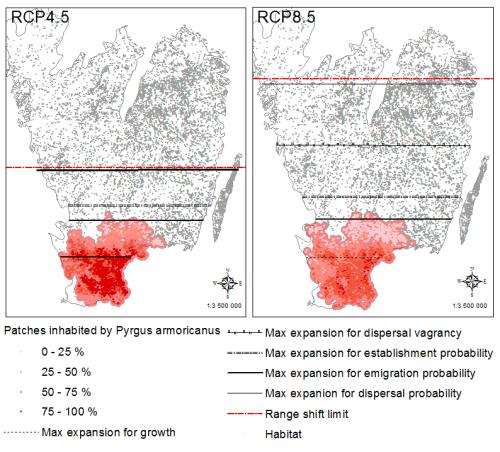
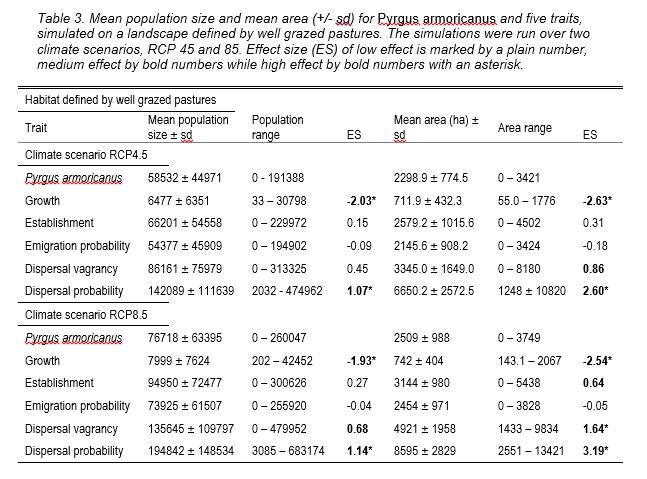
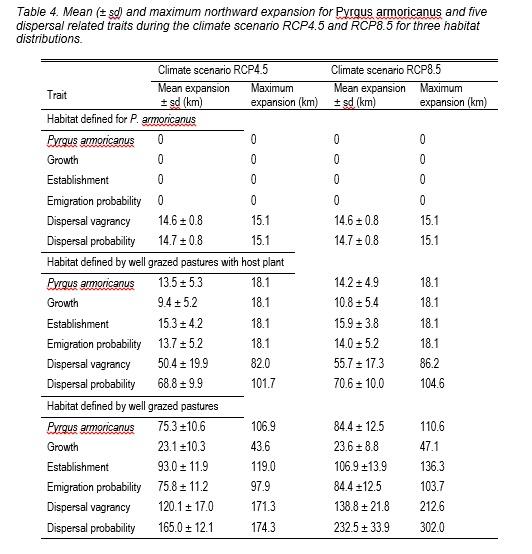
Responsible for this page:
Director of undergraduate studies Biology
Last updated:
05/11/17

